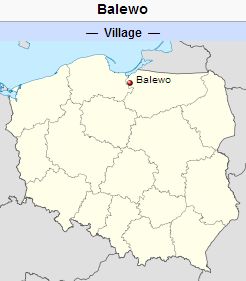Difference between revisions of "Baalau (Warmian-Masurian Voivodeship, Poland)"
| [checked revision] | [checked revision] |
m (Added image.) |
AlfRedekopp (talk | contribs) m (Text replacement - "cms/ct/" to "pages/forschungshilfen/") |
||
| (One intermediate revision by one other user not shown) | |||
| Line 9: | Line 9: | ||
The 1776 Prussian census lists nine Mennonite families in Baalau with the following surnames: Claasen, Funck, Horn, Liebert, Nickel, Penner, Quiring, and Scheffler. In 1820, Baalau had 106 residents, including 37 Mennonites. In 1903 three families in Baalau were members of the Thiensdorf-[[Markushof (Warmian-Masurian Voivodeship, Poland)|Markushof]] Mennonite Church, and in 1935 there were three families named Froese and two named Ott that were members of the [[Thiensdorf and Preußisch Rosengart Mennonite Church (Warmian-Masurian Voivodeship, Poland)|Thiensdorf-Preußisch Rosengart]] congregation. | The 1776 Prussian census lists nine Mennonite families in Baalau with the following surnames: Claasen, Funck, Horn, Liebert, Nickel, Penner, Quiring, and Scheffler. In 1820, Baalau had 106 residents, including 37 Mennonites. In 1903 three families in Baalau were members of the Thiensdorf-[[Markushof (Warmian-Masurian Voivodeship, Poland)|Markushof]] Mennonite Church, and in 1935 there were three families named Froese and two named Ott that were members of the [[Thiensdorf and Preußisch Rosengart Mennonite Church (Warmian-Masurian Voivodeship, Poland)|Thiensdorf-Preußisch Rosengart]] congregation. | ||
= Bibliography = | = Bibliography = | ||
| − | Stowarzyszenie Konserwatorów Zabytków. "Balewo." Catalogue of Monuments of Dutch Colonization in Poland. 2005. Web. 12 February 2013. | + | Stowarzyszenie Konserwatorów Zabytków. "Balewo." Catalogue of Monuments of Dutch Colonization in Poland. 2005. Web. 12 February 2013. http://holland.org.pl/art.php?kat=obiekt&id=289&lang=en. |
Wikipedia. "Balewo, Warmian-Masurian Voivodeship." Web. 12 February 2013. [http://en.wikipedia.org/wiki/Balewo,_Warmian-Masurian_Voivodeship http://en.wikipedia.org/wiki/Balewo,_Warmian-Masurian_Voivodeship]. | Wikipedia. "Balewo, Warmian-Masurian Voivodeship." Web. 12 February 2013. [http://en.wikipedia.org/wiki/Balewo,_Warmian-Masurian_Voivodeship http://en.wikipedia.org/wiki/Balewo,_Warmian-Masurian_Voivodeship]. | ||
| − | Wolf, Hans-Jürgen. "Familienforschung in Westpreußen." Web. 12 February 2013. | + | Wolf, Hans-Jürgen. "Familienforschung in Westpreußen." Web. 12 February 2013. http://www.westpreussen.de/pages/forschungshilfen/ortsverzeichnis/details.php?ID=256. |
= Maps = | = Maps = | ||
[[Map:Balewo, Warmian-Masurian Voivodeship, Poland|Map:Balewo, Warmian-Masurian Voivodeship, Poland]] | [[Map:Balewo, Warmian-Masurian Voivodeship, Poland|Map:Balewo, Warmian-Masurian Voivodeship, Poland]] | ||
{{GAMEO_footer|hp=|date=February 2013|a1_last=Thiessen|a1_first=Richard D|a2_last=|a2_first=}} | {{GAMEO_footer|hp=|date=February 2013|a1_last=Thiessen|a1_first=Richard D|a2_last=|a2_first=}} | ||
| + | [[Category:Places]] | ||
[[Category:Cities, Towns, and Villages]] | [[Category:Cities, Towns, and Villages]] | ||
[[Category:Cities, Towns, and Villages in Poland]] | [[Category:Cities, Towns, and Villages in Poland]] | ||
Latest revision as of 15:47, 23 June 2020

Source: Kujawsko-Pomorska Biblioteka Cyfrowa.
Baalau (also known as Balwe, Balaw, and Balewo; now known as Balewo; coordinates: 54.061, 19.403 [54° 3′ 39″ N, 19° 24′ 10″ E]; population in 1905, 124; in 2013, 90) is located approximately 12 kilometers (7.5 miles) south of Elbląg (Elbing), 23 km. (14 miles) east of Malbork (Marienburg), and 25 km. (16 miles) south-east of Nowy Dwór Gdański (Tiegenhof). It was situated south of Thiensdorf and Hohenwalde.
Baalau was founded in 1631 by Dutch colonists. Until 1772 the village was located in what was known as Royal Prussia (also known as Polish Prussia) in the Kingdom of Poland. The First Partition of Poland in 1772 resulted in the creation of a new province in 1773, called West Prussia, in which the village was located. The village was situated in the district (Kreis) of Marienburg until the end of World War I, when it came under the jurisdiction of the German province of East Prussia. At the outbreak of World War II in 1939, it came under the control of Nazi Germany. In February 1945 it was occupied by Soviet forces and eventually returned to Poland. In 2012 Baalau (now Balewo) was a village in the administrative district of Gmina Markusy, within Elbląg County, Warmian-Masurian Voivodeship.
The 1776 Prussian census lists nine Mennonite families in Baalau with the following surnames: Claasen, Funck, Horn, Liebert, Nickel, Penner, Quiring, and Scheffler. In 1820, Baalau had 106 residents, including 37 Mennonites. In 1903 three families in Baalau were members of the Thiensdorf-Markushof Mennonite Church, and in 1935 there were three families named Froese and two named Ott that were members of the Thiensdorf-Preußisch Rosengart congregation.
Bibliography
Stowarzyszenie Konserwatorów Zabytków. "Balewo." Catalogue of Monuments of Dutch Colonization in Poland. 2005. Web. 12 February 2013. http://holland.org.pl/art.php?kat=obiekt&id=289&lang=en.
Wikipedia. "Balewo, Warmian-Masurian Voivodeship." Web. 12 February 2013. http://en.wikipedia.org/wiki/Balewo,_Warmian-Masurian_Voivodeship.
Wolf, Hans-Jürgen. "Familienforschung in Westpreußen." Web. 12 February 2013. http://www.westpreussen.de/pages/forschungshilfen/ortsverzeichnis/details.php?ID=256.
Maps
Map:Balewo, Warmian-Masurian Voivodeship, Poland
| Author(s) | Richard D Thiessen |
|---|---|
| Date Published | February 2013 |
Cite This Article
MLA style
Thiessen, Richard D. "Baalau (Warmian-Masurian Voivodeship, Poland)." Global Anabaptist Mennonite Encyclopedia Online. February 2013. Web. 21 Nov 2024. https://gameo.org/index.php?title=Baalau_(Warmian-Masurian_Voivodeship,_Poland)&oldid=168568.
APA style
Thiessen, Richard D. (February 2013). Baalau (Warmian-Masurian Voivodeship, Poland). Global Anabaptist Mennonite Encyclopedia Online. Retrieved 21 November 2024, from https://gameo.org/index.php?title=Baalau_(Warmian-Masurian_Voivodeship,_Poland)&oldid=168568.
©1996-2024 by the Global Anabaptist Mennonite Encyclopedia Online. All rights reserved.
